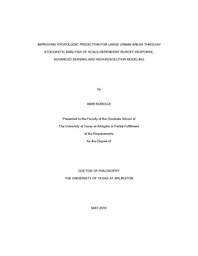| dc.description.abstract | Due to urbanization and climate change, large urban areas such as the DallasFort
Worth Metroplex (DFW) area is vulnerable not only to river flooding but also flash
flooding. Due to the nonstationarities involved, projecting how the changes in land cover
and climate may modify flood frequency in large urban areas is a challenge. Part I of this
work develops a simple spatial stochastic model for rainfall-to-areal runoff in urban areas,
evaluates climatological mean and variance of mean areal runoff (MAR) over a range of
catchment scales, translates them into runoff frequency as a proxy for flood frequency,
and assesses its sensitivity to precipitation, imperviousness and soil, and their changes.
The results show that the variability of MAR in urban areas depends significantly on the
catchment scale and magnitude of precipitation, and that precipitation, soil, and land
cover all exert influences of varying relative importance in shaping the frequency of MAR,
and hence flood frequency, for different sizes of urban areas. The findings indicate that,
due to large sensitivity of frequency of MAR to multiple hydrometeorological and
physiographic factors, estimation of flood frequency for urban catchments is inherently
more uncertain, and the approach developed in this work may be useful in developing
bounds for flood frequencies in urban areas under nonstationary conditions arising from
climate change and urbanization.
High-resolution hydrologic and hydraulic models are necessary to provide
location- and time-specific warnings in densely populated areas. Due to the errors in
precipitation input, and model parameters, structures and states, however, increasing the
nominal resolution of the models may not improve the accuracy of the model output. Part
II of this work tests the current limits of high-resolution hydrologic modeling for real-time
forecasting by assessing the sensitivity of streamflow and soil moisture simulations in
urban catchments to the spatial resolution of the rainfall input and the a priori model
parameters. The hydrologic model used is the National Weather Service (NWS)
Hydrology Laboratory’s Research Distributed Hydrologic Model (HLRDHM) applied at
spatial resolutions of 250 m to 2 km for precipitation and 250 m to 4 km for the a priori
model parameters. The precipitation input used are the Collaborative Adaptive Sensing of
the Atmosphere (CASA) and the Multisensor Precipitation Estimator (MPE) products
available at 500 m and 1 min, and 4 km and 1 hr spatiotemporal resolutions, respectively.
The streamflow simulation results were evaluated for two urban catchments of 3.4 to 14.4
km2 in Arlington and Grand Prairie, TX. The streamflow observations used in the
evaluation were obtained from water level measurements via the rating curves derived
from 1-D steady-state non-uniform hydraulic model. The soil moisture simulation results
were evaluated for three locations in Arlington where observations are available at depths
of 0.05, 0.10, 0.25, 0.50 and 1.00 m. The soil moisture observations were obtained from
three Time Domain Transmissometry (TDT) and Time Domain Reflectometry (TDR)
sensors newly deployed for this work. The results show that the use of high-resolution
QPE improves streamflow simulation significantly, but that, once the resolution of QPE is
increased to the scale of the catchment, no clear relationships are found between the
simulation accuracy and the resolution of the QPE or hydrologic modeling, presumably
because the errors in QPE and models mask the relationships. The soil moisture results
suggest that there are disparate infiltration processes at work within a small area in
Arlington, and that, while the near-surface simulation of soil moisture is generally skillful,
the Sacramento soil moisture accounting model – heat transfer version (SAC-HT) in
HLRDHM has difficulty in simulating the vertical dynamics of soil moisture. The findings
point to real-time updating of model states to reduce uncertainties in initial soil moisture
conditions, and the need for a dense observing network to improve understanding and to
assess the impact at the catchment scale.
Continuing urbanization will continue to alter the hydrologic response of urban
catchments in the DFW area and elsewhere. To assess the impact of recent land cover
changes in the study area and to predict what may occur in the future, streamflow and
soil moisture were simulated using HLRDHM at 250 m and 5 min resolution with the
National Land Cover Data of 2001, 2006 and 2011 for five urban catchments in Arlington
and Grand Prairie, TX. The analysis indicates that imperviousness increased by about 15
percent in the DFW area between 2001 and 2011. The findings indicate that, in terms of
peak flow, time-to-peak and runoff volume, small events are more sensitive to changes in
impervious cover than large events, increase in peak flow is more pronounced for
catchments with larger increase in impervious cover, increase in peak flow is also
impacted by changes in antecedent soil moisture due to increased impervious cover,
runoff volume is not significantly impacted by changes in impervious cover, and changes
in time-to-peak relative to the response time of the catchment is impacted by the location
of the land cover changes relative to the outlet and the time-to-peak itself. In particular,
the Johnson Creek Catchment in Arlington (~40 km2), which has a time-to-peak of only
40 min, shows larger sensitivity in time-to-peak to land cover changes due presumably to
the proximity of the area of increased land cover to the catchment outlet. For further
evaluation, however, dense observation networks for streamflow and soil moisture, such
as the Arlington Urban Hydrology Testbed currently under development, are necessary in
addition to the CASA network of X-band polarimetric radars for high-resolution
quantitative precipitation information (QPI). | |


